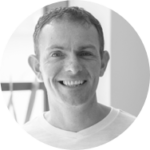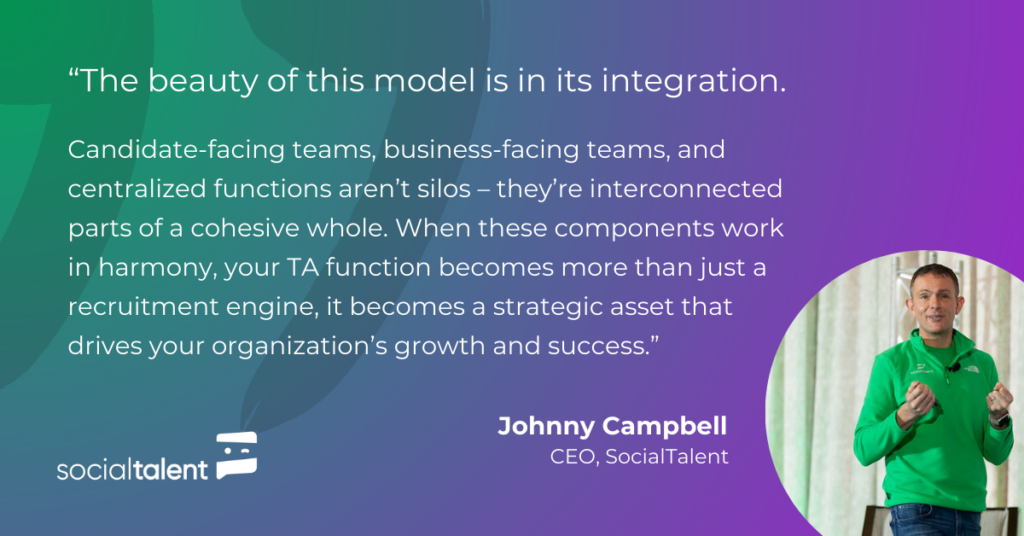
By Johnny Campbell
The talent market has never been more critical.
The ability to attract, engage, and retain top talent isn’t just important at the moment – it’s a big differentiator between those who thrive and those who just barely survive.
But what does it take to build a talent acquisition function that not only meets today’s hiring needs but scales efficiently, maintains quality and diversity, and consistently delivers superior hiring outcomes?
Over the years, I’ve seen countless organizations wrestle with this challenge and it’s a common question I get asked by TA leaders. Many have tried various models and strategies, are stuck using traditional, inefficient approaches to hiring, or even lack a cohesive approach altogether – it can be a quagmire from company to company!
What everyone really wants to know is: what does great TA look like? How do you get to that point, how do you change your culture, and centralize the practical elements?
It’s a big and tricky question to navigate. But at its core is making sure you have the fundamental structures in place. There’s no point throwing tools, technology, and processes on a structure that is set up wrong from the start. So let’s break down what a world class structure looks like.
The Three Pillars of a World-Class TA Organization
At the heart of a successful TA function are three critical components:
- Candidate-Facing Teams
- Business-Facing Teams
- Centralized/ Shared Functions.
Each plays a unique role in creating a seamless, efficient, and scalable recruitment process.
1. Candidate-Facing Teams: The Frontline
These roles, your sourcing, coordination, employer branding, and analytics, are the frontline of the TA organization. Candidate-facing teams are dedicated to understanding the candidate market, building strong relationships, optimizing experience, and maintaining a robust talent pipeline.
- Strategic Sourcing: Successful sourcers don’t just fill immediate openings. They proactively build and maintain pipelines for future demand, ensuring a steady supply of qualified candidates when roles open up.
- Technology-Driven Coordination: With AI and automation transforming recruitment, candidate-facing teams are increasingly relying on technology to streamline logistics. But remember, tech is only as good as the human oversight behind it – maintaining high standards and ensuring an excellent candidate experience remains crucial.
2. Business-Facing Teams: Bridging Recruitment and Business Needs
These teams are your internal consultants, ensuring that your recruitment strategies align with broader business objectives. They’re the ones who understand the nuances of the business, advise on best practices, and make sure that the talent you bring in fits your company’s culture and goals.
- Talent Business Partners/Advisors: These are your strategic liaisons, embedded within business units, who work closely with hiring managers to craft tailored recruitment solutions. Their deep understanding of both the business and the talent market is what drives successful hiring outcomes.
- Beyond Talent Acquisition: In mature organizations, Talent Advisors also play a role in broader talent management – think internal mobility, upskilling, and workforce planning. This holistic approach ensures that your organization isn’t just hiring the right people but also developing and retaining them.
3. Centralized/Shared Functions: The Backbone
The often unsung heroes, centralized functions provide the support, tools, and processes that allow both candidate-facing and business-facing teams to excel.
- TA Operations: This team ensures that your recruitment processes are running smoothly, from managing technology and standardizing processes to producing the analytics and reporting. Their work is what makes a scalable and efficient TA function possible. According to Allyn Bailey, approx 1 in 10 people in your team should be in TA Ops.
- Employer Branding: In today’s globalized talent market, maintaining a consistent employer brand is critical. Your centralized branding team needs to ensure that your messaging resonates not just globally but also locally, adapting to different markets while maintaining a cohesive brand identity.
- Early In Career Recruiting: Hiring people who have no experience requires a different approach to marketing and assessment, therefore it’s usually better that they are separate to your core recruiting team. This team usually hires in seasonal cycles and so are less reactive than your core team.
- Exec Recruiting: Do the math: it probably makes more sense to have at least some of your exec (C minus X) hiring or just your strategic, high touch hiring, in-house. This is long game hiring and typically involves smaller req loads with an approach that better resembles the courting of a professional sports player!

Bringing It All Together
The beauty of this model is in its integration. Candidate-facing teams, business-facing teams, and centralized functions aren’t silos – they’re interconnected parts of a cohesive whole. When these components work in harmony, your talent acquisition function becomes more than just a recruitment engine, it becomes a strategic asset that drives your organization’s growth and success.
If you have only one recruiter, of course, this isn’t going to work for you – but it’s possible to begin to think like this if you have a minimum of two recruiters! You won’t have the centralized functions, but you can begin to think about a separate candidate facing recruiter and talent advisor.
I’ve seen many teams try to optimize only for the candidates, with recruiters aligned by the skills / roles they hire for. The challenge is that they only work with the business when each department has a need for that functional skill, which might be irregular, so they never develop a true understanding of the needs of each team. Also, hiring managers have to deal with an endless stream of different recruiters for each role they are hiring for, rather than having one trusted, go-to person for all of their needs.
Conversely, only optimizing for the business needs means you lose track of the candidate market and will never be able to build long term pipelines and relationships. The result? Your recruiters won’t be able to bring much to the table in terms of expertise when it comes to candidate skills and the market.
So, what’s the takeaway here? Building a world-class TA organization isn’t just about having the right people in the right roles – it’s about structuring your function in a way that aligns with your organization’s needs, scales with its growth, and evolves with the changing talent landscape.




